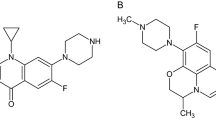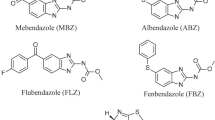Summary
Rimantadine is synthetic analog of amantadine; both are antiviral agents used for prophylaxis and treatment of influenza A. A capillary zone electrophoretic (CZE) procedure for the determination of rimantadine has been developed. As the direct determination of rimantadine is poorly sensitive because the compound is almost transparent in the UV/Vis range, several indirect methods were studied. Two were found to be the particularly useful: (a) indirect detection using 5 mM 4-methylbenzylamine in 1:4 methanol-water as absorbing background electrolyte, with detection at 210 nm, and (b) derivatization of rimantadine with 1,2-naphthoquinone-4-sulfonic acid in alkaline medium and subsequent determination of the derivative by CZE (40 mM tetraborate, pH 9.2, detection at 280 nm). Uncoated capillary tubing, 44 cm length ×75 μM i.d., was used for both determinations. The detection limits were 0.1 and 2 ppm for methods a and b, respectively. The methods were used to determine rimantadine in pharmaceutical products and for dissolution testing of Flumadin® tablets.
Similar content being viewed by others
References
A. Tnusoda, H. F. Maassab, K. W. Cochran, W. C. Eveland Antimicrob. Agents Chemother,1965, 553 (1966).
F. G. Hayden, A. Minocha, D. A. Spyker, H. E. Hoffman, Antimicrob. Agents Chemother.28, 216 (1985).
C. E. Hoffman, Selective Inhibitors of Viral Functions, W. A. Carter, Cleveland, OH, 1980, p. 199.
F. G. Hayden, J. M. Gwaltney, R. L. Van de Castle, K. F. Adams, B. Giordani, Antimicrob. Agents Chemother.19 226 (1981).
F. G. Hayden, H. E. Hoffman, D. A. Spyker, Antimicrob. Agents Chemother.23, 458 (1983).
C. M. Riley, J. M. Ault Jr, J. Chromatogr.531, 295 (1990).
F. A. Rubio, N. Choma, E. K. Fukuda J. Chromatogr.497, 147 (1989).
B. J. Miwa, N. Choma, S. Y. Brown, N. Keigher, W. A. Garland, E. K. Fukuda, N. Choma, S. Y. Brown, N. Keigher, W. A. Garland, E. K. Fukuda, J. Chromatogr.431, 343 (1988).
R. Jannasch, Pharmazie,41, 478 (1986).
A. Revilla, J. Havel, J. Hamáček, Tenth International Symposium on High Performance Capillary Electrophoresis and Related Microscale Techniques, Kyoto, Japan, July 8–11, 1997, poster 114.
H. G. Kristensen, Pharmeuropa8, 386 (1996).
J. Gasparič, J. Churáček, in SNTL, Paper and Thin Layer Chromatography of Organic Compounds (Czech version), Praha, Czech Republic, 1981, p. 181.
Author information
Authors and Affiliations
Rights and permissions
About this article
Cite this article
Revilla, A.L., Hamáček, J., Lubal, P. et al. Determination of rimantadine in pharmaceutical preparations by capillary zone electrophoresis with indirect detection or after derivatization. Chromatographia 47, 433–439 (1998). https://doi.org/10.1007/BF02466475
Received:
Revised:
Accepted:
Issue Date:
DOI: https://doi.org/10.1007/BF02466475




